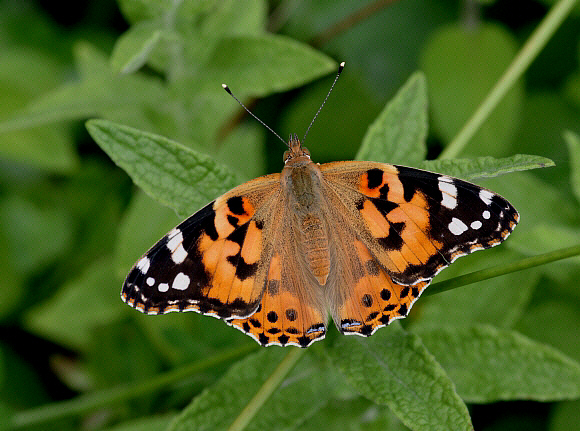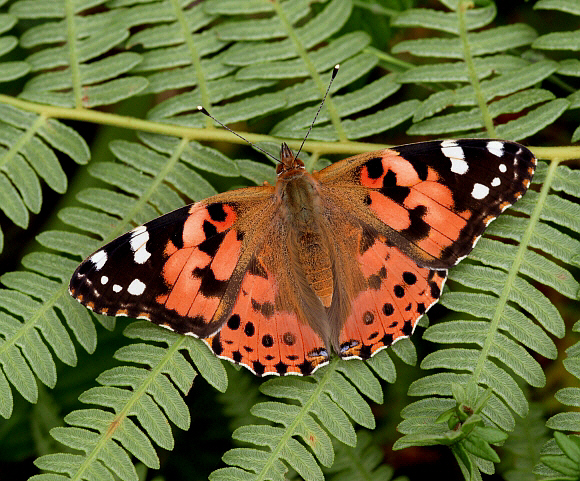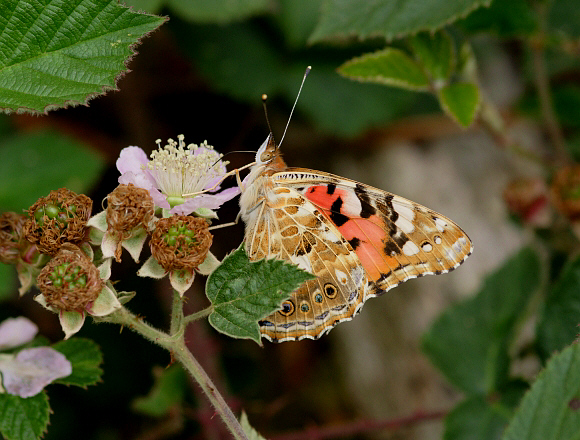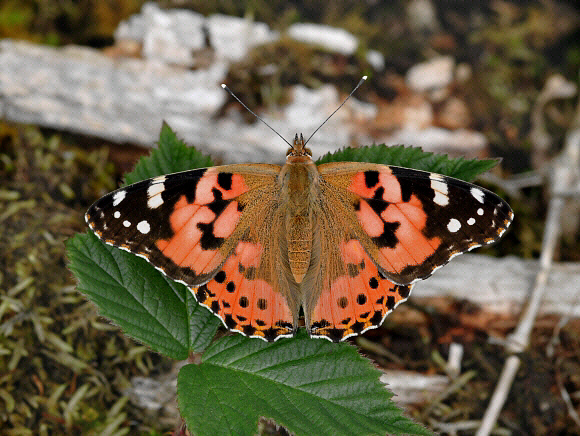Painted Lady Vanessa cardui, Bentley Wood, Wiltshire – Adrian Hoskins
Painted Lady Vanessa cardui, Bentley Wood, Wiltshire – Adrian Hoskins
Introduction
The Painted Lady is the most widely distributed butterfly in the world, found in North America, and south to the Caribbean islands and Venezuela. In the Old World it occurs throughout Europe and temperate Asia, over most of Africa, Madagascar, the Azores, the Canary Islands, the Arab states, and throughout the Indian subcontinent including Sri Lanka. In the Far East it occurs in Thailand, Malaysia, Borneo and Sumatra – and extends it’s range south through the Indonesian islands to Western Australia.
The cosmopolitan distribution of the species results from a combination of its very strong migratory behaviour and its polyphagous nature – in Britain its caterpillars feed almost exclusively on thistles, but elsewhere in the butterfly’s range they use a vast range of foodplants amongst the Malvaceae, Labiatae, Compositae, Boraginaceae, Ulmaceae, Rutaceae, Urticaceae, Rosaceae, Verbenaceae, Leguminosae, Chenopodiaceae, Hydrophyllaceea, Convolvulaceae, Plantaginaceae, Cucurbitaceae, Cruciferae, Umbelliferae, Rhamnaceae, and even one or two grass species !A feature common to most migratory species is that there tends to be very little variation in pattern between individuals. Apart from minor variations in colour a Painted Lady from N.America or Europe will be identical to one from Africa, Indonesia or Australia.
Habitats
In Britain the Painted Lady occurs as a migrant originating from North Africa, Arabia and southern Europe. C.B.
Williams in his book Insect Migration quotes Skertchley, who in March 1869 witnessed the commencement of a migration in desert behind Suakin by the Red Sea :”He noticed that the whole mass of grass, through which they were riding on camels, was in a state of violent agitation although there was no wind. When he dismounted he found that the cause was the emergence from the chrysalis of myriads of Painted Lady butterflies, which dried their wings and about half an hour later flew off together eastwards towards the sea”.
Being an extremely mobile species the Painted Lady can turn up in any almost any habitat – heaths, woodland, grassland, meadows, cliff-tops, urban gardens, city parks and town centres.
Migrants arriving in Britain in May often assemble at hilltop sites in southern England, but they soon disperse inland, and can reach northern Scotland by June. Eggs laid in May will produce a second brood of adults in August, which also migrate northwards and reach Scotland in early September. There does not appear to be any evidence of a southward return migration, but occasional records of Painted Ladies in January appear to indicate that the butterflies attempt to hibernate at certain sites on the south coast, although they do not seem able to survive the frosts of February.
The numbers arriving in Britain in the spring depends very much on weather conditions in Africa and continental Europe. A wet winter in north Africa can cause a huge population explosion and trigger a massive migration in which tens of thousands, or even tens of millions of Painted Ladies head north across the Mediterranean. They usually cross from Algeria and Tunisia to Italy, then east through Hungary, and then radiate out across northern Europe, laying eggs and producing successive generations along the route. Others follow a different route, heading north from Morocco to Spain and France, but numbers arriving in Britain via this route are usually lower. The butterflies also spread south from Morocco, heading around the coast of West Africa to Gambia and Nigeria.
|
estimated numbers of MIGRANTS and UK-bred Painted Ladies, summer 2009 |
||||||||||||||||||||||||||||
|
millions |
April |
May |
June |
July |
Aug |
Sept |
Oct |
|||||||||||||||||||||
|
16 |
||||||||||||||||||||||||||||
|
15 |
||||||||||||||||||||||||||||
|
14 |
||||||||||||||||||||||||||||
|
13 |
||||||||||||||||||||||||||||
|
12 |
||||||||||||||||||||||||||||
|
11 |
||||||||||||||||||||||||||||
|
10 |
||||||||||||||||||||||||||||
|
9 |
||||||||||||||||||||||||||||
|
8 |
||||||||||||||||||||||||||||
|
7 |
||||||||||||||||||||||||||||
|
6 |
||||||||||||||||||||||||||||
|
5 |
||||||||||||||||||||||||||||
|
4 |
||||||||||||||||||||||||||||
|
3 |
||||||||||||||||||||||||||||
|
2 |
||||||||||||||||||||||||||||
|
1 |
||||||||||||||||||||||||||||
|
0.5 |
||||||||||||||||||||||||||||
|
0.25 |
||||||||||||||||||||||||||||
|
In 2009 a colossal migration took place. A wet winter, resulting in lush plant growth, caused a vast population to build up in the Sousse Valley in Morocco. Immediately after emerging in March, the butterflies began migrating. Most appear to have headed directly north into Spain, while others headed east, crossing the Mediterranean from Tunisia to Italy. By mid May a vast 850 mile wide migratory front had built up stretching from Spain to Poland. For several days their passage to Britain was impeded by a low pressure system. Then in late May a change of weather brought warm sunny conditions to the UK, and aided by southerly winds millions of Painted Ladies crossed the channel. The influx included tens of thousands of faded individuals, and their offspring – lesser numbers of very fresh specimens that had bred and emerged in southern Europe. Observers from all over England reported almost unprecedented numbers, e.g. 80 seen in half an hour at Newhaven on 25th May, 96 in less than 10 minutes at Granborough, Bucks; and a colossal 800 per hour at Strumpshaw Fen in Norfolk ! On 30th May, as the migration subsided, a timed census by observers at 180 sites from Cornwall to Skye produced a count of 20,000 butterflies. Using this data Professor Chris Thomas estimated that at least 15 million Painted Ladies were in Britain during the 2 hours when the census took place. On arrival in Britain the butterflies soon began laying eggs, and before long huge numbers of Painted Lady caterpillars were being reported. In two fields at Port Isaac in Cornwall, observers discovered an estimated half a million caterpillars. Another vast breeding site was discovered near Ditchling in Sussex, where between 250,000-300,000 adults were estimated to have emerged on a 200×300 metres patch of thistle-covered hillside ! |
The chart above illustrates the massive immigration of Painted Ladies into Britain during May 2009. More migrants continued to arrive, albeit in much lower numbers, throughout the summer. The 1st brood of UK-bred adults emerged in vast numbers between mid-July and early August. The progeny of these butterflies emerged in much lower numbers during September and early October. Painted Ladies were not the only migrants to appear in 2009. There were also huge immigrations of Large White and Clouded Yellow; and above average numbers of Small White and Red Admiral. Other notable migrants included Long-tailed Blue, Short-tailed Blue & Queen of Spain Fritillary.
Painted Lady Vanessa cardui, Bentley Wood, Wiltshire – Adrian Hoskins
Lifecycle
In Britain the pale green eggs are nearly always laid on spear thistle Cirsium vulgare, creeping thistle C. arvense, or welted thistle Carduus acanthoides, but there are occasional records of nettle Urtica dioica or greater burdock Arctium lappa being used.
The eggs are laid singly on the upper surface of terminal leaves, and hatch after about a week.
The young larvae spin a silk web on the underside of a thistle leaf. They feed on the lower cuticle, leaving distinctive patches visible on the upper surface. When older they eat the entire leaf with the exception of the central vein and the spines. The fully grown larva is black, with a prominent yellow broken stripe along each side. It lives and feeds within a tent of leaves spun together with silk. These silk tents, in which the conspicuous droppings are enmeshed, make the larvae easy to find.
In early July the larva spins together a new tent of leaves, within which it pupates. The chrysalis is greyish pink, with an overall golden lustre.
Adult behaviour
On overcast days, the butterflies often spend long periods basking in rabbit scrapes or other small depressions on the ground, and are frequently seen basking on patches of bare chalk.
Males establish territories at ride intersections within woodland, or in sheltered dry gullies, chalk pits, or around field edges where they are sheltered by hedgerows. I have also commonly found them aggregating at hilltop sites e.g. at Old Winchester Hill NNR, and Noar Hill, both in Hampshire. They generally have about 4 or 5 spots within their territories where they regularly bask.
The butterflies are powerful flyers and habitually fly from flower to flower, stopping for just a few seconds at each to take nectar. They visit a wide range of species including marjoram, knapweeds, thistles, burdock, hemp agrimony, fleabane, devil’s bit scabious, and bramble blossom; and in gardens will nectar at buddleia, michaelmas daisies, sedum and many other cultivated flowers.

Painted Lady Vanessa cardui, Hampshire – Adrian Hoskins



